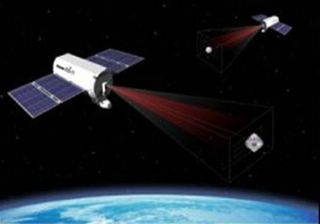
By Kelly Young
NewScientist.com news service
4-12-05
The US Air Force has launched a micro-satellite that could lead to an autonomous robotic mechanic that fixes satellites in orbit. The launch is the first of two such technology-demonstration satellites to lift off this week.
The 138-kilogram XSS-11 - which stands for Experimental Spacecraft Systems 11 - blasted off at 0635 PDT (1435 GMT) on Monday from Vandenberg Air Force Base in California, US, aboard a Minotaur rocket.
“Nobody’s ever done anything like this in space,” says Vernon Baker, XSS-11 programme manager at the Space Vehicles Directorate at Kirtland Air Force Base, New Mexico, US. He says developing an ability to inspect or repair in orbit will significantly lower the cost of running satellites.
During its mission, the XSS-11 craft will approach dead or unused US satellites or old rocket parts. At each rendezvous, the Air Force satellite will burn its engines to move around the object while taking a range of pictures.
Normally, ground controllers instruct a satellite when to fire its engines. But, after a commissioning and testing phase, XSS-11 will only take instruction on where to find a dead satellite. Then, with its on-board planner, it will calculate when to burn its engines.
Anti-satellite weapon
During its lifetime, XSS-11 will rendezvous with six to eight objects, the first of which will probably be the upper stage of the Minotaur rocket that carried it into space. The Air Force wants to be able to service and inspect military satellites in space.
However, Theresa Hitchens, vice president for the Center for Defense Information, a think-tank in Washington, DC, says that the XSS-11 satellite could be the predecessor for a space-based weapon. If a micro-satellite could approach other satellites, she says, it could also adjust its speed and ram into the satellite, damaging it or knocking it off course. And smaller satellites are more difficult to detect from the ground. But officially, the US Air Force has no offensive satellite weapons program.
NASA is also interested in using such technology for a Mars-sample-return mission, so that a lander would be able to dock autonomously with a mother ship after a visit to the surface. Spacecraft autonomy is one of the requirements for President George W Bush’s plan for human missions to the Moon and Mars.
Another autonomous spacecraft, NASA’s Demonstration of Autonomous Rendezvous Technology (DART) satellite, is scheduled for take-off on a Pegasus rocket on 15 April. It too will make its own approach to a satellite, testing techniques required to dock on auto-pilot.
After some costly delays, DART ended up costing $110 million. “It’s a much simpler mission,” Baker told New Scientist. It is expected to operate for about 24 hours. The Air Force expects the XSS-11 to operate for between 12 and 18 months and its final cost is $80 million. It weighs about half as much as the DART satellite.
No comments :
Post a Comment
Dear Reader/Contributor,
Your input is greatly appreciated, and coveted; however, blatant mis-use of this site's bandwidth will not be tolerated (e.g., SPAM, non-related links, etc).
Additionally, healthy debate is invited; however, ad hominem and or vitriolic attacks will not be published, nor will "anonymous" criticisms. Please keep your arguments/comments to the issues and subject matter of this article and present them with civility and proper decorum. -FW